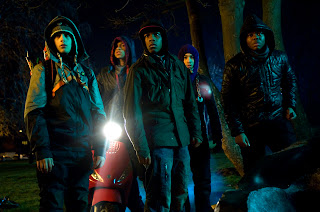
My last post addressed the way in which
straights (non horror fans) can have a tendency to look down their noses at horror fans, like we're Trekkies or something. They only do this because they're ignorant. It's our duty as fans to try to remedy this ignorance. Following are a few tips from my own experience that I hope will help my fellow genre fans to convert the unwashed masses.
1) The Classics Are Your Cornerstone
The classics are considered classics for a reason. It's no accident that every Halloween brings a wave of those "Ten Best Horror Movies To Watch On Halloween" lists from a slew of straight websites. Sure, you'll see some variation, but these lists are mostly populated from a pool of the same titles on every single site. We horror fans generally roll our eyes and think something like "
The Exorcist? Again?" Still, though, you'd be surprised how many straights have never seen
The Exorcist.
The classics are a great place to let your student dip a foot into the bloody pool of horror, because your student will want to see these titles for many of the same reasons that filmmakers want to remake them. Even if your subject has never seen these movies, he's at least aware of them. He already has at least a vague idea of what they're about, often because he's already seen some of those aforementioned remakes. Yes, even straights who profess not to like horror movies will occasionally go to see one - just goofin' - and chances are, what they saw was probably a remake with a familiar title. Take the "in" and show them the original.
2) Know Your Student
Don't show a pregnant woman
It's Alive (1974). The amusement to be had from watching her squirm uncomfortably will be fleeting. You've made watching a horror movie a distinctly unpleasant experience for her, and that only serves to reinforce her claim that she doesn't like horror. She won't trust your recommendations in the future because she won't trust your motives.
 |
| Lena Leandersson - Let The Right One In (2008) |
Take time to find out what kind of movies your student
does like, and choose a title that somehow ties into that. If she likes arty foreign films, show her
Let The Right One In (2008). If she likes comedies, show her
Shaun Of The Dead (2004). If she likes being intellectually engaged by a movie, show her
Pontypool (2008). Remember that your student already has preconceived notions about the horror genre. You're trying to make an end run around those preconceptions in the hopes of demonstrating that the horror genre is multifaceted enough to encompass movies that even she will enjoy.
3) Make It A Learning Experience
Some
people respond well to the idea of developing an intellectual
appreciation for something even when they believe that something doesn't
actually appeal to them. Sometimes that intellectual appreciation can
develop into a genuine enthusiasm once they've become attuned to the
particulars of the subject. Use that to your advantage when introducing
someone to the horror genre.
I programmed two
different series of genre movies for some of my students that I referred
to as The Drive-In Movie Summer Series. We watched one movie each
Wednesday for twelve weeks. Prior to starting this undertaking I even
went so far as to create a program schedule with bullet-pointed facts,
trivia, and production info. Putting the movies into some kind of
context for my students before watching them piqued their interest, and
it served to make the whole experience something more than just "horror
guy subjecting straights to B-movies". They were only humoring me at
first, but they were fully and genuinely invested in the experience by
the end of the summer.
 |
| John Travolta - The Devil's Rain (1975) |
Be careful, though. Don't
get too bogged down in horror-centric details and lose sight of your
goal. For example, one of the movies we watched was
The Devil's Rain (1975),
and I made sure my resident John Travolta fan knew he was in it. That's
a bullet-point that mattered to her. On the other hand, telling her it
was directed by the same guy who directed
The Abominable Dr. Phibes (1971) would have meant nothing to her. This leads nicely into number four . . .
4) Build On Your Successes
If you show your student a Fulci movie and he objects to the graphic violence, shelve the Fulci movies until later. If you show your student an Argento movie and he objects to the lack of narrative cohesion, fall back to horror movies with more linear narratives. Don't force the issue. There may be an opportunity to reintroduce Fulci or Argento later, but only if your student is still
watching horror movies later. Some directors, subgenres, and styles are acquired tastes. I was only lukewarm on Argento's
Suspiria (1977) the first time I saw it, and that's almost unfathomable to me now. My tastes had to broaden and mature. Your student will never get to that point if you insist upon beating him relentlessly about the face and neck with movies you think he
should like.
Use softer "gateway" horror like
Gremlins (1984),
Poltergeist (1982), or
Arachnophobia (1990) first to get a feel for what your student might find tolerable, then branch out from there into thematically similar "hard" horror. Take the time to build a foundation for your student's education. We all had to walk before we ran.
5) Recognize Your Student's Opinions Are Valid (Even If They're Wrong)
You will inevitably show your student a horror movie you love that he doesn't care for. Don't get discouraged. Don't take it personally. This is an opportunity, not a setback.
 |
| Angus Scrimm - Phantasm (1979) |
Ask your student to identify what they found unappealing about the movie. Gently prod them into examining critically exactly
why they didn't like it. Resist the urge to tell them they're wrong and then proceed to explain to them why they're wrong for half an hour. Instead, turn their criticisms back on them, and make this an opportunity for them to examine what in particular didn't appeal to them. This will, in turn, prompt them to consider what they
do like. You've now made your student an active participant in his education, strengthened his own critical faculties, encouraged him to view a horror movie as a topic worthy of examination, and let him know it's o.k. if he doesn't like everything he sees. You can deal with the fact that he's a nutcase for not enjoying
Phantasm (1979) at a later date.
6) Be Prepared For The Day The Student Becomes The Master
If you've done your job well, this will happen. You'll have another horror literate friend with whom to watch your favorites. All of those years you spent amassing a wealth of useless knowledge about the horror genre will not have been wasted. When you help your student develop her affinity for zombie movies and
she later comes to
you interested in watching
The Battery (2012), you'll know you've succeeded.
So what tactics have worked for you? Post a comment below to share your own tips. One final note: I was just joshing with that Trekkie slur at the start of this post. I like
Star Trek. Really.
Posted by Brandon Early




























